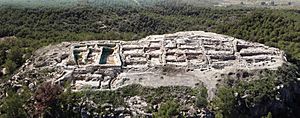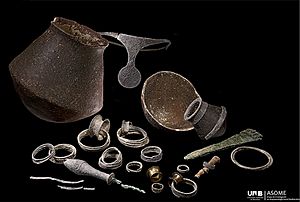La Almoloya facts for kids
La Almoloya is an amazing archaeological site located in the southeast of Spain. It's a very important place for studying the Bronze Age period. This site was home to a powerful group of people called the El Argar culture. They lived from about 2200 BC to 1500 BC. Their territory was huge, covering an area similar in size to modern-day Belgium.
Contents
Discovering La Almoloya: A Bronze Age City
La Almoloya is not just a small village. It was a significant city during the Bronze Age. Archaeologists have been digging here since 2014. They have found many exciting things that tell us about life long ago. This site helps us understand how people lived, worked, and even how their society was organized.
The Rich Burial of Grave 38
One of the most exciting discoveries at La Almoloya is a special burial site called "grave 38." This grave was found beneath the floor of a large building. Inside, archaeologists found the bones of a woman and a man. What makes this grave so special are the many valuable items buried with them. Most of these treasures were found with the woman.
Treasures of Grave 38: Silver and Gold
The woman in grave 38 was buried with many precious items made of silver. These are called "grave goods." One of the most important finds was a beautiful silver diadem, which is like a crown. There were also gold bracelets and other valuable objects. Experts believe these silver treasures are worth a lot of money.
Who Were the People in Grave 38?
Scientists used a method called radiocarbon dating to find out when the burial happened. They found that the couple was buried around 1700 BC. Later, in a different grave at the site, archaeologists found the bones of a baby girl. This infant was a direct descendant of the couple from grave 38. This tells us that the family was important and lived in this area for generations.
Powerful Women in the El Argar Culture
The discovery of so much silver with the woman in grave 38 is very interesting. Other important El Argar women found at the site also had silver treasures buried with them. This suggests that women in the El Argar culture might have held powerful political positions. They may have been leaders or had a lot of influence in their society. This is different from what we often imagine about ancient times.
The Bronze Age Palace: A Place for Politics
Above grave 38, archaeologists found the remains of a very large building. Some experts believe this building might be one of the earliest Bronze Age palaces in Western Europe. It was a big hall with benches built along the sides. There was also a raised platform near a hearth, which provided heat and light. This hall could seat about 50 people.
A Unique Meeting Place
This building is very special because it seems to have been a place for politics. It's unique among the hundreds of buildings found from the El Argar culture. This means it was likely used for important meetings and decisions. Leaders would gather here to discuss issues and govern their people. It shows that the El Argar culture had a well-organized society with a clear system of governance.
See also
 In Spanish: La Almoloya para niños
In Spanish: La Almoloya para niños



